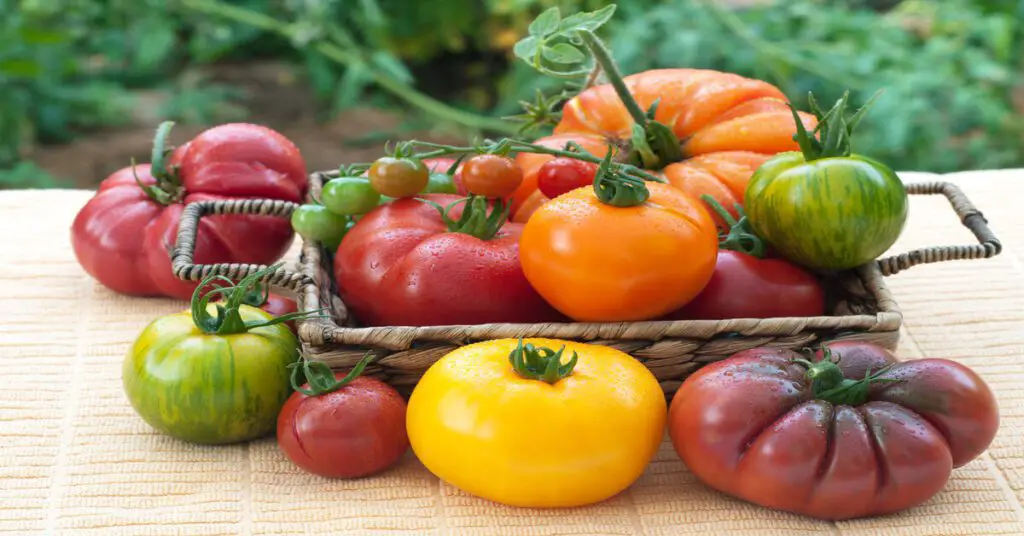If you’ve ever strolled through a farmer’s market, you may be surprised to find tomatoes that aren’t red like the ones typically found at the supermarket.
9 out of 10 times, if the tomato is not red, then it is probably an heirloom tomato.
What makes an heirloom tomato special? Are hybrid tomatoes inferior? What even makes an heirloom tomato “heirloom” anyway?
We’ll answer these questions and go over some of the key differences between hybrid and heirloom tomatoes that often confuse even experienced chefs.
What is an heirloom tomato?
The term heirloom tomato was first coined in the 1970s to describe a certain type of tomato with pure lineage and history, although the precise definition is open to debate in agricultural circles.
In general, heirloom tomatoes are often considered “untampered” with, though they may have been naturally selected or bred in the past before commercial hybrid seeds were developed.
Typically, heirloom tomatoes become heirloom when they have existed stably for 40 years or more. However, some regard 50 years as the standard, or even delineate heirlooms as tomatoes growing before 1940.
Again, the precise definition is unclear.
Characteristics of heirloom tomatoes:
Although the definition is unclear, many consider below the key characteristics which make heirloom tomatoes “heirloom”:
- Open-pollination: All heirloom tomatoes are open-pollinated, meaning they pollinate themselves without any human intervention.
- More Diversity: Because of their open-pollination, heirlooms from time to time can create new cultivars naturally or via selective breeding. In practice, this means heirloom tomatoes come in a greater variety of colors, shapes, textures, and tastes than hybrids.
- Breeds true to type: Even though they are open-pollinating (meaning new heirlooms can be naturally created), most heirlooms tend to self-pollinate in 99% of cases. Self-pollination allows heirlooms to breed true to type from generation to generation.
- Consistency: Because seeds breed true to type, heirloom tomatoes tend to have consistent flavors, textures, and colors across generations.
- Long history: There is no formal technical definition of an heirloom, but it’s commonly accepted that heirlooms need to have been cultivated for at least 40-50 years combined with the above characteristics.
Characteristics of hybrid tomatoes:
Hybrid tomatoes, on the other hand are created in controlled environments, are associated with the below characteristics:
- Controlled cross-pollination: The parents of hybrid tomatoes have been carefully selected, and pollination has been engineered in a controlled environment to create seeds that amplify the desired characteristics of each parent.
This type of engineering does not occur in the wild and is more labor intensive, making hybrid seeds more expensive.
- Less diversity: Because they are typically selected for certain commercially viable traits (e.g. longer shelf life and thick skins), hybrids tend to fall within a narrow window of popular types: red, thicker-skinned, and predictable consistent tomato taste.
- Does not breed true to type: Because hybrids have been engineered and are genetically unstable, hybrid offsprings tend to lose the selected characteristics over successive generations and do not breed true to type. However, first generation hybrids do well and tend to have more beneficial traits than parents due to something called “hybrid vigor.”
- Inconsistent over generations: Because they are genetically unstable, hybrids will revert or lose traits (e.g. any unique taste, disease-resistance, size, coloring) over successive generations. To maintain consistency, new engineered hybrid seeds must be re-purchased every year. [1]
Health Benefits: Heirloom vs. Hybrid
The topic of whether hybrids or heirlooms are healthier is a subject of open debate as tomatoes, including heirlooms or hybrids, will differ nutritionally even within the same breed.
All tomatoes are rich in vitamins A, C, and K1, potassium folate, beta carotene, and lycopene.
Further complicating this is the fact that new breeds of tomatoes are constantly coming out, including newer hybrids combining two heirloom varieties or more nutritional benefits.
However, according to an Ohio State University study, orange tangerine tomatoes have more amounts of one particularly type of cis-lycopene than red tomatoes.
According to the study, cis-lyocpenes found in orange tomatoes are 2.5x easier to absorb than regular trans-lycopenes found in red tomatoes. [2]
However, this study should be taken with a grain of salt, as it focuses very narrowly on particular types of orange vs. red tomatoes for one nutrient.
References:
[1] Porter, J. (n.d.). Hybrids & Heirlooms. Illinois Master Gardener, University of Illinois Extension.Retrieved on October 24, 2022 from https://extension.illinois.edu/sites/default/files/ dkk-mg-seed-swap-hybrid-heirloom.pdf.
[2] Lafferty, M. (2007). Orange tomatoes healthier than red. The Columbus Dispatch. https://cpb-us-w2.wpmucdn.com/u.osu.edu/dist/0/14595/files/2015/07/Orange-tomatoes-healthier-than-red-1hn1jr7.pdf

